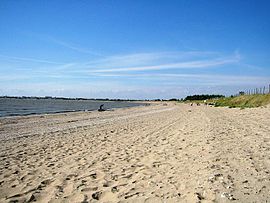Aytré
Aytré | |
|---|---|
 Beach at Aytré | |
| Coordinates: 46°08′05″N 1°06′48″W / 46.1347°N 1.1133°W | |
| Country | France |
| Region | Nouvelle-Aquitaine |
| Department | Charente-Maritime |
| Arrondissement | La Rochelle |
| Canton | Aytré |
| Intercommunality | CA La Rochelle |
| Government | |
| • Mayor (2020–2026) | Tony Loisel[1] |
Area 1 | 12.22 km2 (4.72 sq mi) |
| Population (2022)[2] | 9,759 |
| • Density | 800/km2 (2,100/sq mi) |
| Time zone | UTC+01:00 (CET) |
| • Summer (DST) | UTC+02:00 (CEST) |
| INSEE/Postal code | 17028 /17440 |
| Elevation | 1–21 m (3.3–68.9 ft) |
| 1 French Land Register data, which excludes lakes, ponds, glaciers > 1 km2 (0.386 sq mi or 247 acres) and river estuaries. | |
Aytré (French pronunciation: [ɛtʁe]) is a commune in the Charente-Maritime department, Nouvelle-Aquitaine, southwestern France.
Aytré is especially known for its long beach, which is easily accessible from neighbouring La Rochelle, or Les Minimes. The beach is flat and shallow, making it a good bathing spot for children, and an excellent spot for windsurfing.
The historian Jean Prasteau (1921–1997) was born in Aytré, as was Jean Desaguliers, a Protestant pastor, and father of John Theophilus Desaguliers.
Economy
[edit]Industries are few, and economic activity mainly gravitates around La Rochelle, with the distinct exception of Alstom Transportation. The world's fastest train, TGV, was designed right in Aytré. Oysters are cultivated in the bay and important camping grounds have been developed for tourists during the summer period.
History
[edit]During the Siege of La Rochelle, Cardinal de Richelieu spent time in a farm just to the south of Aytré.

Population
[edit]
|
| ||||||||||||||||||||||||||||||||||||||||||||||||||||||||||||||||||||||||||||||||||||||||||||||||||||||||||||||||||
| Source: EHESS[3] and INSEE (1968-2017)[4] | |||||||||||||||||||||||||||||||||||||||||||||||||||||||||||||||||||||||||||||||||||||||||||||||||||||||||||||||||||
See also
[edit]References
[edit]- ^ "Répertoire national des élus: les maires" (in French). data.gouv.fr, Plateforme ouverte des données publiques françaises. 13 September 2022.
- ^ "Populations de référence 2022" (in French). The National Institute of Statistics and Economic Studies. 19 December 2024.
- ^ Des villages de Cassini aux communes d'aujourd'hui: Commune data sheet Aytré, EHESS (in French).
- ^ Population en historique depuis 1968, INSEE
External links
[edit]





